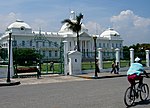Portal:Haiti/Selected article
| This page is currently inactive and is retained for historical reference. Either the page is no longer relevant or consensus on its purpose has become unclear. To revive discussion, seek broader input via a forum such as the village pump. |
| Note: Article entries are now being transcluded directly on the main portal page. However, this page should be retained for historical reference. |
Usage
The layout design for these subpages is at Portal:Haiti/Selected article/Layout.
Layout template
{{Portal:Haiti/Selected article/Layout
|image=
|size=
|caption=
|text=
|link=
}}
- Add a new Selected article to the next available subpage.
- Update "max=" to new total for its {{Random portal component}} on the main page.
Selected articles list
Selected article 1
Portal:Haiti/Selected article/1
The Haitian Revolution (1791-1804) was the most successful of the many African slave rebellions in the Western Hemisphere and established Haiti as a free, black republic, the first of its kind. At the time of the revolution, Haiti was a colony of France known as Saint-Domingue. By means of this revolution, Africans and people of African ancestry freed themselves from French colonization and from slavery.Haiti is the first black republic in modern history. It went directly from being a French colony to self-governance through a process that has had lasting effect on the nation. The system established by slaveholders demonstrated the effectiveness of violence and force in controlling the majority. This system survived the revolution and continued under the nascent black republic. A light-skinned elite took control of political and economic power.
Selected article 2
Portal:Haiti/Selected article/2
Politics of Haiti takes place in a framework of a presidential republic, whereby the President of Haiti is both head of state and head of government, and of a multi-party system. Executive power is exercised by the government. Legislative power is vested in both the government and the two chambers of the National Assembly of Haiti. The government is organized unitarily, thus the central government delegates powers to the departments without a constitutional need for consent. The current structure of Haiti's political system was set forth in the Constitution of March 29, 1987.Selected article 3
Portal:Haiti/Selected article/3
François-Dominique Toussaint Louverture (French: [fʁɑ̃swa dɔminik tusɛ̃ luvɛʁtyʁ], English: /ˌluːvərˈtjʊər/) also known as Toussaint L'Ouverture or Toussaint Bréda (20 May 1743 – 7 April 1803), was a Haitian general and the most prominent leader of the Haitian Revolution. During his life, Louverture first fought and allied with Spanish forces against Saint-Domingue Royalists, then joined with Republican France, becoming Governor-General-for-life of Saint-Domingue, and lastly fought against Bonaparte's republican troops. As a revolutionary leader, Louverture displayed military and political acumen that helped transform the fledgling slave rebellion into a revolutionary movement. Along with Jean-Jacques Dessalines, Louverture is now known as one of the "Fathers of Haiti".
Toussaint Louverture was born as a slave in the French colony of Saint-Domingue, now known as Haiti. He was a devout Catholic, and was manumitted as an affranchi (ex-slave) before the French Revolution, identifying as a Creole for the greater part of his life. During his time as an affranchi, he became a salaried employee, an overseer of his former master's plantation, and later became a wealthy slave owner himself; Toussaint Louverture owned several coffee plantations at Petit Cormier, Grande Rivière, and Ennery. At the start of the Haitian revolution he was nearly 50 years old and began his military career as a lieutenant to Georges Biassou, an early leader of the 1791 War for Freedom in Saint-Domingue. Initially allied with the Spaniards of neighboring Santo Domingo, Louverture switched his allegiance to the French when the new Republican government abolished slavery. Louverture gradually established control over the whole island and used his political and military influence to gain dominance over his rivals. (Full article...)
Selected article 4
Portal:Haiti/Selected article/4 The 2010 Haiti earthquake was a catastrophic magnitude 7.0 Mw earthquake, with an epicenter near the town of Léogâne (Ouest department), approximately 25 km (16 miles) west of Port-au-Prince, Haiti's capital. The earthquake occurred at 16:53 local time (21:53 UTC) on Tuesday, 12 January 2010.
By 24 January, at least 52 aftershocks measuring 4.5 or greater had been recorded. An estimated three million people were affected by the quake; the Haitian government reported that an estimated 316,000 people had died, 300,000 had been injured and 1,000,000 made homeless. The government of Haiti also estimated that 250,000 residences and 30,000 commercial buildings had collapsed or were severely damaged.
The earthquake caused major damage in Port-au-Prince, Jacmel and other settlements in the region. Many notable landmark buildings were significantly damaged or destroyed, including the Presidential Palace, the National Assembly building, the Port-au-Prince Cathedral, and the main jail. Among those killed were Archbishop of Port-au-Prince Joseph Serge Miot, and opposition leader Micha Gaillard. The headquarters of the United Nations Stabilization Mission in Haiti (MINUSTAH), located in the capital, collapsed, killing many, including the Mission's Chief, Hédi Annabi.
Nominations
Feel free to add featured, top or high importance Haiti articles to the above list.



